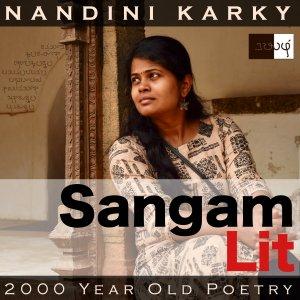Sangam Lit

Aganaanooru 69 – Far but never forgotten
In this episode, we listen to words of encouragement, as depicted in Sangam Literary work, Aganaanooru 69, penned by Umattoor Kizhaar Makanaar Parankotranaar. The verse is situated in the ‘Paalai’ or ‘Drylands landscape’ and renders hope to a despairing heart.
ஆய்நலம் தொலைந்த மேனியும், மா மலர்த்
தகை வனப்பு இழந்த கண்ணும், வகை இல
வண்ணம் வாடிய வரியும், நோக்கி,
ஆழல் ஆன்றிசின் நீயே. உரிதினின்
ஈதல் இன்பம் வெஃகி, மேவரச்
செய் பொருள் திறவர் ஆகி, புல் இலைப்
பராரை நெல்லி அம் புளித் திரள் காய்
கான மட மரைக் கணநிரை கவரும்
வேனில் அத்தம் என்னாது, ஏமுற்று,
விண் பொரு நெடுங் குடை இயல் தேர் மோரியர்
பொன் புனை திகிரி திரிதரக் குறைத்த
அறை இறந்து அகன்றனர்ஆயினும், எனையதூஉம்
நீடலர் வாழி, தோழி! ஆடு இயல்
மட மயில் ஒழித்த பீலி வார்ந்து, தம்
சிலை மாண் வல் வில் சுற்றி, பல மாண்
அம்புடைக் கையர் அரண் பல நூறி,
நன்கலம் தரூஉம் வயவர் பெருமகன்
சுடர் மணிப் பெரும் பூண் ஆஅய் கானத்துத்
தலை நாள் அலரின் நாறும் நின்
அலர் முலை ஆகத்து இன் துயில் மறந்தே.
Back in the drylands and we catch the confidante speaking these thoughtful words to the lady:
“Perceiving your form that has lost its old beauty, your eyes that have shed their flower-like, admirable allure, your lines that are now shorn of their bright hues, don’t you cry and lose yourself in worry. Desiring to attain the rightful joy that arises from giving unto others, he has gone in search of wealth, with that confused heart of his, not minding the scorching heat of the drylands, where sour clusters of fruit from the small-leaved, thick-trunked gooseberry tree are seized by huge herds of forest deer.
The Moriyars, with swaying chariots, decked with tall royal umbrellas, soaring to the skies, so as to ensure their gold-etched strong wheels journey on without obstacles any, have made paths by reducing and shaping boulders on the way. Even if he has gone to that faraway place, he will not delay his journey, my friend, may you live long! Gathering feathers, shed by naive, dancing peacocks, they decorate around their resounding, sturdy bows, and holding intricate arrows in their hands, they shatter forts many and gather fine ornaments as tributes. Such is the nature of soldiers in the army of the great and famous King Aay, who wears huge ornaments with radiant sapphires. Akin to the fragrance of a flower on the first day of bloom in Aay’s forest, are your wide bosoms. How can he stay away, forgetting his sweet sleep on those bosoms of yours?”
Time for a gooseberry treat in the drylands! The confidante starts by asking the lady not to lament over the lady’s diminished beauty, as reflected in her skin and eyes, owing to the man’s parting away. She talks about how he has left in search of wealth only because he has the noble aim of rendering to those, who come seeking to him, reiterating the Sangam belief that people went in search for wealth, not for their personal gain, but for the purpose of compassion and charity. Describing how the man can now be found in the hot drylands, she mentions that the only available food there are sour gooseberries and even those are snatched away by hordes of deer.
Then, changing track she goes on to talk about the ‘Moriyars’, most probably referring to the ‘Mauryas’, who ruled North India between the 4th and the 2nd century BCE. After mentioning their striking chariots with huge royal umbrellas, the confidante remarks on how the Mauryas used to shatter and reduce mountain boulders in their path, so as to keep moving on their wheels. Let’s return to this detail in a short while. The confidante has referred to these kings only to say that even if the man had gone to those faraway places, where the Mauryas are known to have paved paths, the man shall not delay his return. As an argument for her statement, the confidante goes on to talk about another king, Aay, detailing on the valour of his soldiers, and their skill in archery and extracting tributes from foes, turning specifically to the forests in this king’s domain. Here, she zooms on to the fragrance of a flower that has just bloomed in this celebrated forest, and equates it to the fragrance of the lady’s bosom, and concludes by saying the man could not possibly stay away for long, forsaking his sleep on the lady’s bosom.
With glowing praise and a warm understanding, the confidante hopes to allay the lady’s anxiety. Returning to that historic reference of the Mauryas, which have already seen in Puranaanooru 175, this line offers a hint of the road-building capabilities of this clan of kings, by talking about how they wouldn’t let even mountains stop them in their conquest of other regions, shattering rocks and paving roads. Other historians such as the Greek Megasthenes concur with this statement in his description of the roads built by the Maurya kings in his ancient text ‘Indika’. It is said that these kings came as far south as Northern Karnataka, but never conquered the ancient Tamil regions ruled by the Chera, Chozha and Pandya kings, and were to said to have good trade relationship with these southern rulers. Gratifying to see how these splashes of history on various canvases paint a rich and layered sketch of the diverse regions in ancient India!






 Visit Podcast Website
Visit Podcast Website RSS Podcast Feed
RSS Podcast Feed Subscribe
Subscribe
 Add to MyCast
Add to MyCast